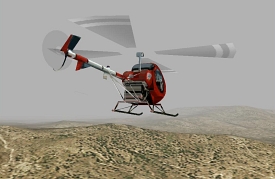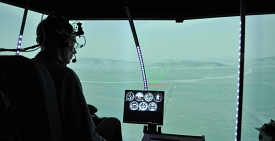
Simulated flight into the mist
NLR conducted intensive research to assess how innovative visual concepts could improve the flight safety of small helicopters to the desired standard.
European and American aviation authorities agree that the flight safety of small helicopters is not improving quickly enough. They encounter problems with alarming regularity, especially when visibility is poor. The majority of helicopters in this class are not equipped with the avionics that ensure safe flight under such conditions, or the pilots are insufficiently experienced or trained to use such equipment effectively. NLR conducted a risk analysis in 2012 and identified a number of technical solutions that might reduce the risk.
Based on an extensive analysis of numerous cases, two types of common accidents or incidents were identified. The first type occurs when poor weather causes the pilot to lose sight of the ground and steer the helicopter incorrectly, often with fatal consequences. The second type is almost the same as the first, except that the pilot takes no corrective measures at all, with similar consequences.
NLR proposed four possible solutions, or concepts, that require only minor adjustments to the cockpit. Three of these concepts are optical, while the third one is acoustic.
NLR technicians first modified the Helicopter Pilot Station (HPS) so that this simulated cockpit environment matched that of smaller type helicopter, which was the study’s specific area of interest. Subsequently, a number of pilots who were inexperienced with instrument flying were tested in various scenarios. This included flights in swiftly changing weather or visually challenging circumstances in wintery, mountainous terrain. Without extra technical modifications, it quickly became clear how real the risks were, with some pilots suffering virtual crashes.

Peripheral horizon for small helicopters
One of the technical solutions that NLR proposed was the so-called Heads Up Display Orange Peel, whereby symbols were projected on the canopy to indicate the position of the horizon and whether the helicopter was descending or ascending. Other potential solutions were the Malcolm Horizon, which is a horizon line projected inside across the entire canopy, and the Peripheral Horizon, consisting of strips of LED lights that help to improve the pilot’s situational awareness and thus reduce accident risk.
The Helicopter Terrain Avoidance Warning System used a computer-generated voice to automatically warn the pilot when the helicopter was at risk of encountering a dangerous position in relation to the terrain.
The HPS was then modified for further test flights, during which pilots could assess which of these measures was most effective. The conclusions of this study have now been shared with the client, the European Aviation Safety Agency (EASA), which means that industry can be approached to further develop the most promising solution.
Also visit our Rotorcraft Flight Procedures capability page.


